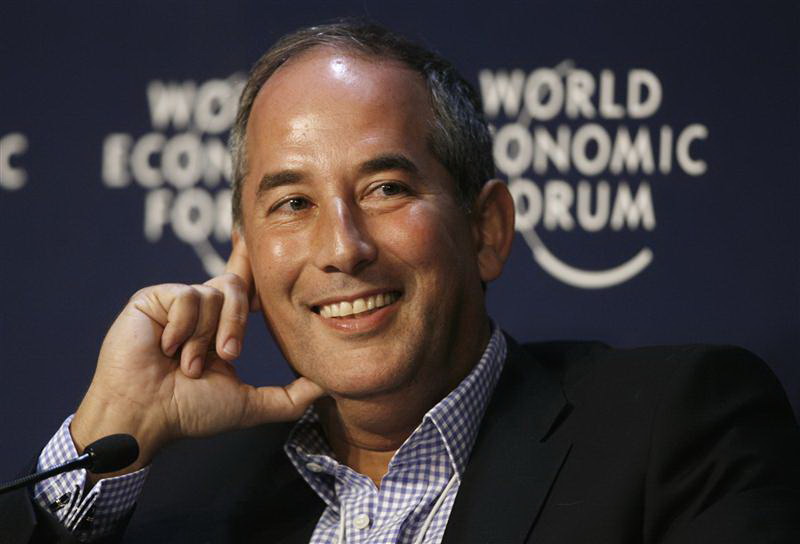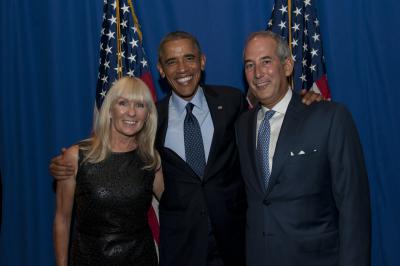I was recently interviewed by Bluevoyant LLC, the cyber defense company I co-founded and chair, on my predictions for the post-COVID business world. While it remains premature to proclaim the end of COVID, with novel vaccines now well on their way to market, I hazard the following.
This year, COVID-19 has disrupted businesses and global economies in extraordinary ways. Add to this a highly controversial US Election and Brexit, whereby the UK could leave the EU without a deal, and you can start to see how organizations have been forced to consider a different type of future. Here, former CEO of Thomson Reuters and BlueVoyant Executive Chairman, Tom Glocer, provides his view on the business outlook and trends challenging boards in 2021.
Prediction/trend 1 – Lack of resilience in supply chains
There are a conjoined set of issues around the vulnerabilities of our supply chain that COVID-19 has unmasked. The primary one is around the active ingredients in vaccines and pharmaceutical drugs; many of whcih have been single-sourced from China or India. But the issues extend beyond the pharmaceutical industry and are far larger, for example, in the tech world, the Apple supply chain has also been affected — many components are manufactured in China. Likewise, components for batteries and rare earth minerals are being sourced from both friendly and unfriendly places.
Going forward, there will be multiple years of effort to either repatriate supply chains or at the very least, a requirement to make them more durable. This is a move towards anti-globalization. The current model works from a cost efficiency standpoint. However, this may not be the case moving forward, whereby we will likely see a deterioration in the level of just-in-time integration of supply chains.
Prediction/trend 2 – Real estate and travel will change indefinitely
Real estate and travel have arguably been the two sectors most impacted by COVID-19. When we have some return to normality, will we go back to flying again with the regularity that we did before the pandemic? Likewise, will we go back to offices operating in the same way and what sort of offices will these be? With remote/home working resulting in a distributed employee base, this presents a subsequently larger cyber attack surface. Employees using their own devices on home networks will continue to be a challenge for organizations. In certain sectors, such as financial services, organizations have home devices completely locked down but the average commercial/industrial enterprise doesn’t have such a disciplined remote set up and therefore we will continue to see adversaries using ‘Bring Your Own Device’ (BYOD) as an attack vector.
But how many offices will close down? And if we reduce travel what impact will this have on airlines and the travel industry as a whole? The nature of the work we perform in offices and at home will change. People will go to work to collaborate. Therefore, solo work in an individual office is likely to reduce significantly. In fact, solo working will only be undertaken in the office if the employee cannot work from home.
The sight of an office-based employee wearing headphones to aid concentration will therefore become more rare — if you need to isolate to work effectively and have the space at home you will work at home. As a result, we will see an evolution in the type of spaces required with more conference and meeting rooms, and open collaborative work areas. This will force employees to be more deliberate about scheduling their activities.
Prediction/trend 3 – A recession was inevitable
In terms of spending and investment, even if organizations cut back in 2021, enterprises will still see the depreciation flow-through some of the big investments that they committed to in 2018-20. However, at the start of 2020 organizations were getting nervous that we were coming to the end of the ‘bull market’ and they had started to trim. But you can’t bring CAPEX to a screaming halt; instead organizations will delay their spend as long as possible.
That said, we will continue to see investment and movement to the cloud, with organizations making their infrastructure as agile and marginal cost oriented as possible. Organizations will try to be very nimble in their spend as they deploy.
Predictions/trend 4 – A focus on rightsizing the business for the future
I sit on three public and five private boards so as you can imagine the challenges being discussed around the boardroom table do vary quite a bit depending on industry and size. One of the companies I work with is an advertising agency holding company. Firstly, the digital shift has impacted their business and secondly, the COVID-19 pandemic has been a huge shock with their clients’ marketing budgets being cut back. This has led to fluctuations in spend, with clients cutting back and then re-investing again.
Therefore, how do you right-size your business and infrastructure in that environment of uncertainty? Certainly, here in the US, the banks have been doing incredibly well, especially the investment banks. Another company whose board I sit on is a large pharmaceutical. The big question they are facing is how fast can we get COVID-19 therapeutics and vaccines out while still meeting the demand for all the other drugs? And if you abstract this challenge and layer it onto other industries, boards will be thinking about how they keep driving forward to meet existing demand, without knowing what that demand will be and not having a fully-secure supply chain.
Prediction/trend 5 – Growth in the gig economy
Whether there will be a consumer recession and an onset of credit problems or not will depend, in part, on government action and stimulus packages. How many people will end up being out of work?
With so many people potentially out of work, will we see an explosion in the gig economy and platforms like Fiverr, SpareHire and Gigster. I’m not just talking about Uber or food delivery and so on, but more business-oriented platforms. Many people who either can’t find work or prefer to work for themselves will be driving demand for these solutions. This will lead to an evolution of business models with employers sourcing from the gig economy. But how do you build a set of services like banking, insurance, and healthcare for this industry? This brings into focus a number of issues around trust and payments. For example, how do you deliver services for a client in Turkey if they want to pay you in Turkish Lira?
Prediction/Trend 6 – Acceleration of digital transformation business plans
Owing to the pandemic, we’ve seen three to five-year digital transformation plans being squeezed into three to five-months. Many businesses are scrambling to get their heads around what has happened whereby five years of technological transformation has happened in mere months. And, while there is certainly a perception that we have seen enormous transformation, I believe this is because the penny has only just dropped with the older generation that we can do things differently – and that may even mean ‘better’. When I was CEO at Thomson Reuters, I always felt there was a real divide between the digital natives and digital immigrants. So, I think digital transformation initiatives have been held back by a bunch of 50 and 60-year olds who weren’t convinced, who didn’t even know how to schedule their own Zoom meetings. Now suddenly, through adversity, they realize they can do this and it is actually a better way of working – they are digital immigtrants!
Prediction/Trend 7 – Diversity, ethics, ESG and sustainability
In the US, the Black Lives Matter movement has reset responsibilities and priorities. However, one of the challenges for public boards is how do you take these issues, and those such as environmental, social and governance (ESG) issues beyond virtue signaling to reality? Do you write letters to your whole business ecosystem saying, ‘we expect everyone to adhere to this policy’? How do you police your whole supply chain and ensure they are procuring ethically and responsibly? It is significantly harder to make the substantive change, than to sign off the press release or marketing campaign.
Movements and initiatives such as ESG will only resonate when boards start to financially account for climate change. For example, this will occur when board executives can monetize the true cost of climate change. Up to now it has really only been insurers who have recognized these costs as a result of payment on claims such as those resulting from the Californian and Australian wildfires.
Under the auspices of the former Governor of the Bank of England, Mark Carney, the Sustainability Accounting Standards Board (SASB) championed a great initiative around sustainability accounting for companies. However, in a couple of years’ time all reporting companies will squeal and the PWCs and Deloittes of this world will have a field day as they implement all the accounting and control mechanisms to allow this to happen.
Prediction/Trend 8 – US Election and Biden – A steady period of normalization
In January 2021, we will see a new administration in the White House, leading to a normalization of the US Government. There will be three likely Biden effects: 1.) a divided government with a Republican-controlled Senate, 2.) a short-term stimulus plan; and 3.) a focus on rebuilding government institutions and relationships with traditional allies. With a Senate still likely controlled by the Republicans, true radical change in healthcare or tax policy is unlikely to go through under the Biden administration.
Therefore, we will enter a period of ‘steady as she goes’, which can be good for the markets for a while. We don’t need to do anything radical but stabilize and unite. However, in the long-term – on big issues such as climate change, inequalities in society – the Biden administration won’t be able to make sizable changes, as the government institutions are in gridlock.
Prediction/Trend 9 – Brexit is good for some Nation-states
Brexit is such a gift to the Russians. It takes the UK out of the bloc, as one of its strongest members, and weakens Germany; it makes the EU tip more towards the southern countries. I believe there is a golden thread that links Trumpism in the US, and Brexit. It has been remarkable how much damage has been done.
Prediction/Trend 10 – A shift from vendors to trusted advisors
Here at BlueVoyant, we are in the cyber defense business which will (unfortunately for society) remain a growth industry for a long time.
There is currently a real trend of boardrooms becoming much more involved in cyber, treating it as an existential risk. But boards are now asking core questions – “How much spend is enough? For years my CISO has been telling me I need firewalls, endpoint, agents, etc.” but now most CEO and CFOs want to know “How much am I spending relative to my peers, and how do I benchmark?”
Whether you lose your job after a cyber attack stems largely from whether you did everything reasonable to prevent such an attack or were you delinquent in your duties. This is why boards want to benchmark against their peers. They want to know whether they are spending enough, and in the right areas, enabling them to get a good “bang for the buck”. Those are the key questions in every boardroom.
As many businesses have shifted to the cloud and continue on their migration journey, this has put the spotlight on managed services. As boards and senior executives think through that spend question, they will also be asking whether it makes sense to do it in-house, or whether there is a better way to share and defray the cost of proper defense? If I am one of the main clearinghouse banks i.e. Barclays or Lloyds, I will have a sophisticated set of infrastructures and I can afford the best talent as advisors and heads in my security division. But if I am a tier 2 bank or a building society I can’t spend £100 million on cyber, I can’t afford to pay top money for senior security staff, but I still have SWIFT codes, payment services, and customer data which, if breached, could destroy the business’ reputation. Therefore, how do I get Lloyds-quality defense but at a price and in a manner I can afford? Here is where BlueVoyant can really help.
Ultimately, this will shift power away from vendors in favor of trusted experts and advisors. That trend is real, and the future is already here. But everyone won’t come to that conclusion at once. It will take time.






Very well thought out. I can see that the sustainability of supply chain is going to have to “get real”. This included a real commitment to ESG or there can be brand reputation implications.
Chinese are very far behind in this and it is an advantage for those who figure out your 10 trends.
Thanks,